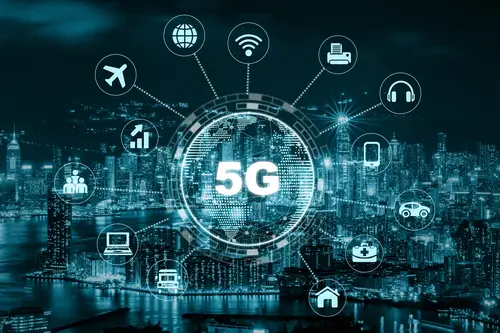Welcome to the fast-paced universe of technology where every blink brings innovation. Our focus today is on ‘5G’ – the fifth-generation mobile network that promises to revolutionize wireless connectivity as we know it! The buzz around 5G has been growing, but many are still in the dark about what it really is and how exactly it’s changing our digital landscape. In this post titled “How 5G will Change the World of Wireless Connectivity”, we will demystify this groundbreaking technology for you. Get ready to delve into not only understanding its high-speed internet capabilities, lower latency and massive device connectivity potential but also exploring how it could impact everyday life, businesses, industries and society at large. So buckle up tech enthusiasts; let’s journey together into a future shaped by 5G!
The Technological Advances of 5G for Wireless Connectivity
5G technology represents a major leap forward in wireless connectivity, promising faster speeds, lower latency, and increased capacity compared to its predecessor, 4G. One of the key technological advances of 5G is its use of high-frequency millimeter waves. This allows us to transmit data at exceptionally high speeds. Additionally, 5G networks utilize advanced beamforming techniques to direct signals more precisely towards specific devices, enhancing efficiency and reducing interference. Moreover, the implementation of massive MIMO (Multiple Input Multiple Output) technology enables 5G networks to support a larger number of connections simultaneously. This paves the way for the Internet of Things (IoT) and other emerging technologies that rely on seamless connectivity.
Implications of 5G for Wireless Connectivity
The advent of 5G technology will revolutionize wireless connectivity in multiple ways. Firstly, the increased speed and bandwidth of 5G networks will enable faster and more reliable connections for users. This means that data transfer rates will be significantly quicker. It allows for real-time applications such as video streaming, online gaming, and augmented reality to function seamlessly without any lag or buffering. Additionally, the low latency of 5G networks will ensure almost instantaneous response times. This makes tasks like remote surgery, autonomous vehicles, and smart city infrastructure more feasible and reliable.
Furthermore, the widespread deployment of 5G infrastructure will lead to greater connectivity in both urban and rural areas. The higher capacity of 5G networks means that more devices can connect simultaneously without compromising performance. This will pave the way for the Internet of Things (IoT) to proliferate, as devices ranging from smart home appliances to industrial sensors can communicate with each other effortlessly. In turn, this connectivity will drive innovation across industries, leading to advancements in healthcare, transportation, agriculture, and more.
Overall, the implications of 5G for wireless connectivity are profound and far-reaching. With faster speeds, lower latency, and increased capacity, 5G networks will not only enhance user experiences but also enable new technologies and services that were previously not possible. As 5G continues to roll out globally, it is poised to reshape the way we interact with technology and each other, ushering in a new era of connectivity and innovation.
Enhancing Device Functionality with 5G Wireless Connectivity
The deployment of 5G technology is set to revolutionize wireless connectivity by enhancing device functionality across various industries. One of the key aspects that 5G is expected to improve is the speed and reliability of wireless networks. With faster data transfer rates and lower latency, devices will be able to communicate more efficiently, leading to seamless connectivity and improved user experiences. This will enable the development of innovative applications and services that were previously limited by the constraints of older wireless technologies.
In addition to speed, 5G technology also promises increased capacity, allowing more devices to connect simultaneously without sacrificing performance. This is essential for the proliferation of Internet of Things (IoT) devices, as well as the implementation of smart city initiatives and autonomous vehicles. The ability of 5G networks to support a massive number of connected devices opens up new possibilities for automation and data analytics. This will lead to more efficient operations in various sectors. Take a look at the Best 5G Technology Devices that will provide faster connection in the modern world.
Furthermore, the low latency offered by 5G networks will enable real-time communication between devices. This will pave the way for advancements in areas like virtual reality, augmented reality, and remote-controlled robotics. This will not only enhance entertainment and gaming experiences but also drive innovation in industries like healthcare, education, and manufacturing. Overall, the deployment of 5G will change the world of wireless connectivity by enhancing device functionality and transforming the way we interact with wireless networks in the future.
Challenges in Implementing the 5G Network
Implementing the 5G network poses several challenges that need to be addressed for successful deployment. One of the main challenges is the need for significant infrastructure upgrades. This includes the installation of thousands of small cells and antennas to support the high-frequency bands used in 5G. This requires coordination among various stakeholders, such as government entities, wireless carriers, and property owners. Another challenge is ensuring adequate spectrum availability for 5G networks to operate efficiently. Spectrum allocation and management are crucial for enabling faster speeds and lower latency. Additionally, concerns about cybersecurity and privacy need to be addressed to protect user data as 5G networks become more widespread. Overall, overcoming these challenges will be essential for the successful rollout of 5G technology.
Future Prospects – Beyond just Faster Speeds
The impact of 5G goes far beyond just faster speeds. With its low latency and high bandwidth capabilities, 5G is set to revolutionize industries such as healthcare, transportation, and manufacturing. The Internet of Things (IoT) will flourish with 5G, enabling seamless connectivity between a vast array of devices. Autonomous vehicles will rely on 5G networks for real-time communication, enhancing safety and efficiency on the roads. In healthcare, remote surgeries and telemedicine will be made more reliable and accessible with the reliability and speed of 5G. The possibilities are endless, with 5G paving the way for a more connected, efficient, and innovative future.

 Exploring the Latest Social Media Trends and How to Use Them
Exploring the Latest Social Media Trends and How to Use Them 10 Hidden iPhone Features You Didn’t Know Existed
10 Hidden iPhone Features You Didn’t Know Existed